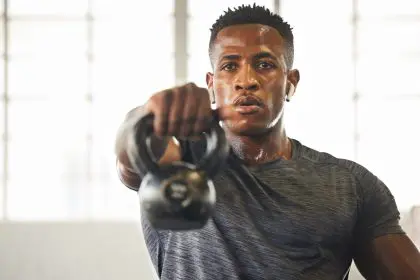Building lean muscle doesn’t require expensive gym memberships or complicated machinery. The humble dumbbell remains one of the most effective tools for sculpting a strong, defined physique that turns heads and boosts confidence. These versatile weights offer unlimited possibilities for transforming your body, whether you’re working out at home or supplementing your gym routine.
The beauty of dumbbell training lies in its simplicity and effectiveness. Unlike machines that lock you into predetermined movement patterns, dumbbells allow your body to move naturally while challenging multiple muscle groups simultaneously. This creates the perfect environment for building lean muscle that looks sculpted rather than bulky.
Understanding how to harness the power of dumbbells can revolutionize your fitness journey. The key lies not just in lifting weights, but in using specific techniques, rep ranges, and programming strategies that maximize lean muscle development while minimizing unwanted bulk.
Why dumbbells reign supreme for lean muscle development
Dumbbells offer unique advantages that make them ideal for building lean, athletic muscle. Their independent nature forces each side of your body to work individually, eliminating strength imbalances that can lead to injury and poor muscle development. This unilateral training approach creates more functional strength that translates to better performance in daily activities and sports.
The stabilization requirements of dumbbell exercises activate smaller supporting muscles throughout your body. This increased muscle activation burns more calories during and after your workout, contributing to the lean, defined look you’re seeking. The constant need to balance and control the weights also improves coordination and proprioception.
Free weights like dumbbells allow for a full range of motion that machines simply cannot match. This complete range of motion ensures optimal muscle fiber recruitment and development, leading to more comprehensive muscle growth and better joint health over time.
The science behind building lean muscle with weights
Lean muscle development occurs through a process called muscle protein synthesis, where your body repairs and builds new muscle tissue in response to resistance training. Dumbbells provide the perfect stimulus for this process when used with appropriate training variables.
The key to building lean rather than bulky muscle lies in training methodology. Higher repetition ranges with moderate weights, combined with shorter rest periods, create the metabolic stress that promotes lean muscle growth while enhancing fat burning. This approach develops muscle endurance alongside strength, creating that coveted toned appearance.
Progressive overload remains crucial for continued muscle development. With dumbbells, you can easily adjust weight, repetitions, or training volume to ensure your muscles continue adapting and growing. This adaptability makes dumbbells perfect for long-term muscle building success.
Essential dumbbell techniques for maximum lean muscle gains
- Compound movement mastery – Focus on exercises that work multiple muscle groups simultaneously. Movements like dumbbell thrusters, renegade rows, and step-ups with overhead press maximize muscle activation while burning significant calories. These exercises create functional strength patterns that enhance overall athleticism.
- Time under tension training – Slow down your repetitions to increase the time your muscles spend under load. This technique enhances muscle fiber recruitment and promotes lean muscle growth. Aim for 2-3 seconds on both the lifting and lowering phases of each repetition.
- Unilateral training emphasis – Single-arm and single-leg dumbbell exercises force your core to work overtime while addressing strength imbalances. This approach builds functional strength while creating better muscle symmetry and definition.
- Circuit-style programming – Combining dumbbell exercises into circuits keeps your heart rate elevated while building muscle. This dual benefit accelerates fat loss while promoting lean muscle development, creating that sculpted look faster.
- Variable grip positions – Changing your grip on dumbbells alters muscle activation patterns and prevents adaptation plateaus. Neutral grips, pronated grips, and supinated grips each target muscles slightly differently, ensuring comprehensive development.
- Eccentric loading focus – Emphasizing the lowering portion of exercises creates significant muscle damage that leads to enhanced recovery and growth. This technique is particularly effective for building lean muscle definition.
- Density training methods – Performing more work in less time challenges your muscles differently and promotes lean muscle development. Try completing the same workout in progressively less time to increase training density.
- Range of motion manipulation – Varying your range of motion throughout sets challenges muscles in different ways. Partial reps, pause reps, and full range movements can all be incorporated strategically for maximum muscle building benefits.
Designing your lean muscle dumbbell program
Effective programming for lean muscle building requires careful consideration of training frequency, volume, and intensity. Training each muscle group 2-3 times per week provides optimal stimulus for growth while allowing adequate recovery time. This frequency ensures consistent protein synthesis activation without overtraining.
Your rep ranges should primarily fall within the 8-15 repetition range for lean muscle development. This range provides enough resistance to stimulate growth while maintaining the higher volume that promotes the lean, toned appearance most people desire. Occasionally incorporating heavier sets of 6-8 reps can boost strength gains.
Rest periods between sets should be kept relatively short, typically 30-60 seconds for smaller muscle groups and 60-90 seconds for larger compound movements. These shorter rest periods maintain training intensity while promoting the metabolic stress that contributes to lean muscle development.
Upper body dumbbell strategies for lean muscle
Upper body training with dumbbells offers incredible versatility for building lean, defined muscle. Focus on compound movements that work multiple muscle groups while incorporating isolation exercises to target specific areas for better definition.
Chest development benefits from various angles and grip positions. Incline, flat, and decline dumbbell presses should form the foundation, supplemented with flyes and pullovers for complete pectoral development. The ability to work each arm independently ensures balanced development and prevents compensation patterns.
Shoulder training with dumbbells allows for natural movement patterns that promote healthy joint function while building impressive muscle definition. Overhead presses, lateral raises, and rear delt flyes create well-rounded shoulder development that enhances your overall physique.
Back training becomes more effective with dumbbells due to the unilateral nature of most exercises. Single-arm rows, reverse flyes, and pullovers target the back muscles from multiple angles while improving posture and creating that coveted V-taper appearance.
Lower body power moves for lean muscle development
Lower body dumbbell training often gets overlooked, but it’s crucial for building a balanced, athletic physique. Dumbbell squats, lunges, and deadlifts provide exceptional muscle-building stimulus while improving functional movement patterns.
Goblet squats teach proper squatting mechanics while building leg strength and muscle. The front-loaded position engages your core throughout the movement, creating additional stability and strength benefits. This exercise alone can transform your lower body development.
Dumbbell lunges in all directions challenge your legs through multiple planes of motion. Forward, reverse, and lateral lunges target different muscle fibers while improving balance and coordination. The unilateral nature of lunges also addresses strength imbalances between legs.
Romanian deadlifts with dumbbells effectively target the posterior chain, including glutes and hamstrings. This movement pattern is essential for balanced leg development and injury prevention, while also contributing to better posture and athletic performance.
Maximizing recovery for lean muscle growth
Recovery plays an equally important role as training in building lean muscle. Your muscles actually grow during rest periods, not during workouts. Ensuring adequate sleep, typically 7-9 hours per night, provides the hormonal environment necessary for optimal muscle protein synthesis.
Nutrition timing around your dumbbell workouts can enhance muscle building results. Consuming protein within 30-60 minutes post-workout provides amino acids for muscle repair and growth. Carbohydrates help replenish energy stores and support the recovery process.
Active recovery between intense dumbbell sessions promotes blood flow and helps remove metabolic waste products. Light activities like walking, swimming, or yoga can accelerate recovery while maintaining movement quality and flexibility.
Progressive overload strategies with dumbbells
Continuous progression is essential for ongoing lean muscle development. With dumbbells, you have multiple variables to manipulate for progressive overload. Increasing weight is the most obvious method, but other strategies can be equally effective.
Adding repetitions to your sets provides overload while maintaining the higher rep ranges beneficial for lean muscle development. Once you can perform the upper end of your target rep range with perfect form, it’s time to increase the weight.
Increasing training volume by adding sets or exercises provides another overload method. This approach works particularly well for lagging muscle groups that need extra attention for balanced development.
Decreasing rest periods between sets increases training density and metabolic stress. This method is particularly effective for promoting the lean, defined look while building muscle endurance.
Common mistakes that sabotage lean muscle gains
Many people sabotage their lean muscle building efforts by training too heavy too often. While strength is important, constantly lifting at maximum intensity can lead to excessive muscle bulk rather than the lean, athletic look most people desire.
Neglecting proper form in favor of heavier weights is another common mistake. Perfect form ensures optimal muscle activation while preventing injury. Focus on feeling the target muscles working rather than simply moving heavy weight.
Inconsistent training frequency prevents the sustained stimulus necessary for lean muscle growth. Sporadic workouts fail to maintain the elevated protein synthesis rates needed for continuous muscle development.
Long-term success with dumbbell training
Building lean muscle is a marathon, not a sprint. Consistency over months and years produces the most dramatic and lasting results. Dumbbell training provides the perfect tool for this long-term approach due to its versatility and adaptability.
As you progress, your training needs will evolve. Dumbbells can accommodate these changes through weight increases, exercise variations, and programming modifications. This adaptability ensures you never outgrow your training tools.
The functional strength and muscle quality developed through consistent dumbbell training creates benefits that extend far beyond appearance. Improved posture, better movement quality, and enhanced athletic performance are just some of the additional rewards of dedicated dumbbell training.
Your journey to building lean muscle with dumbbells starts with a single rep. Every workout builds upon the last, creating cumulative changes that transform your physique and boost your confidence. The power lies in your hands – literally.













